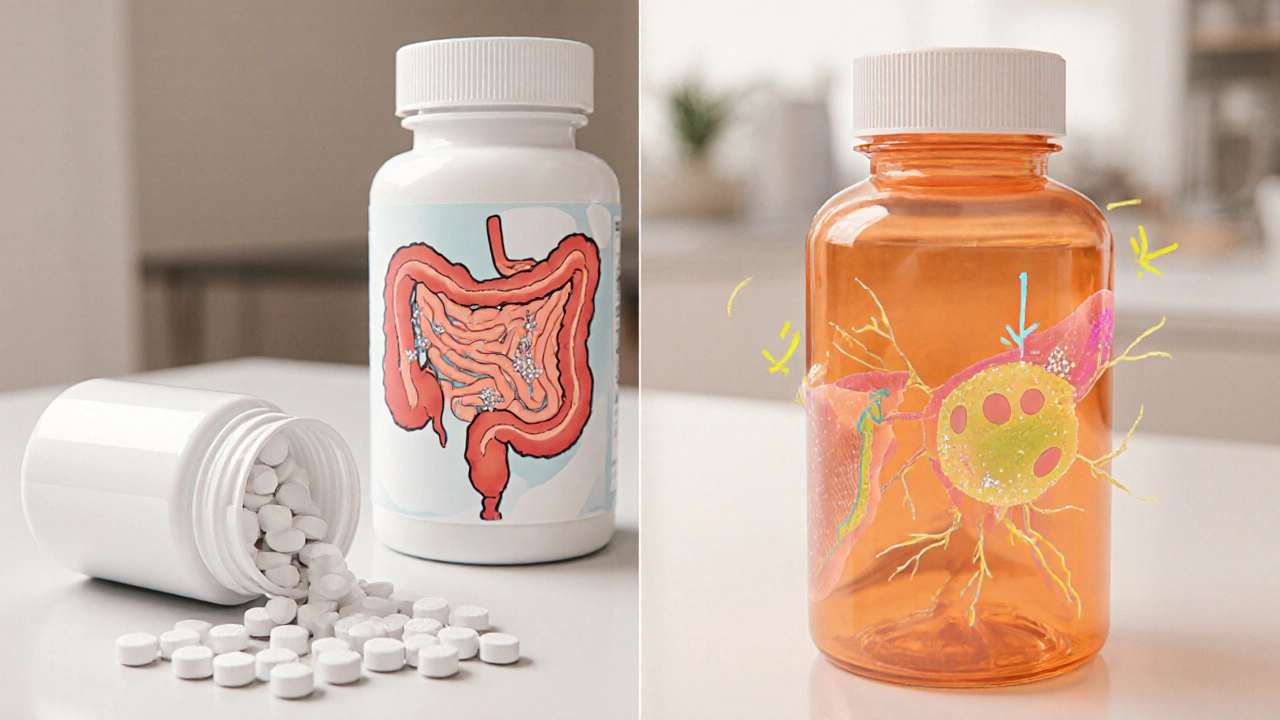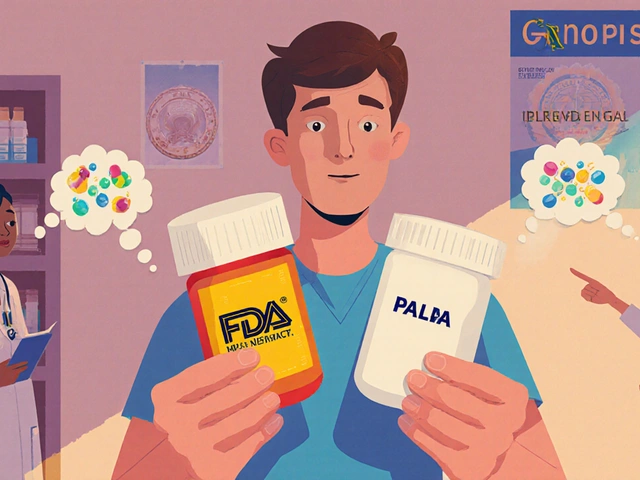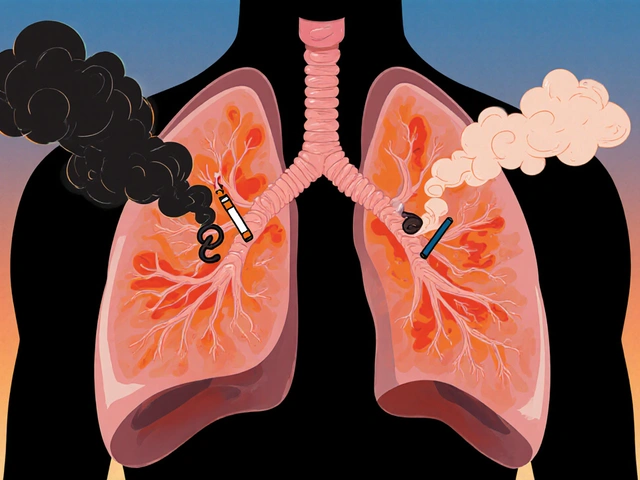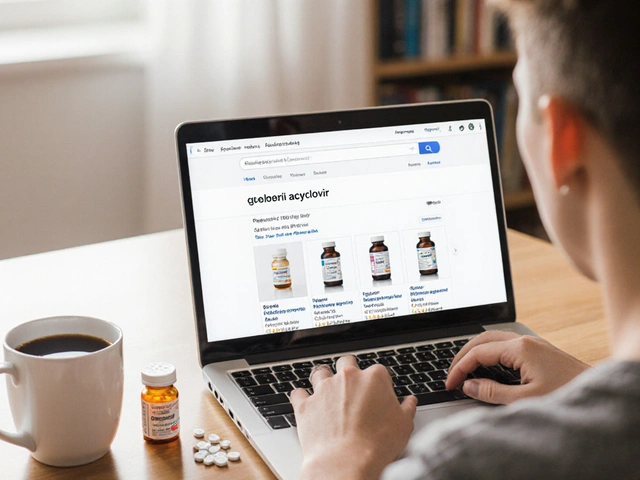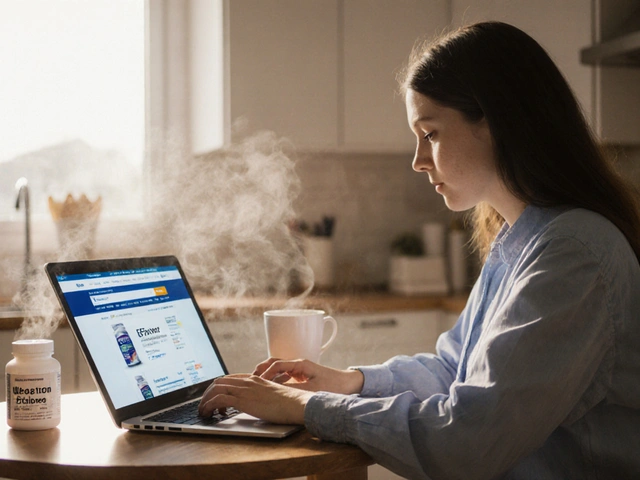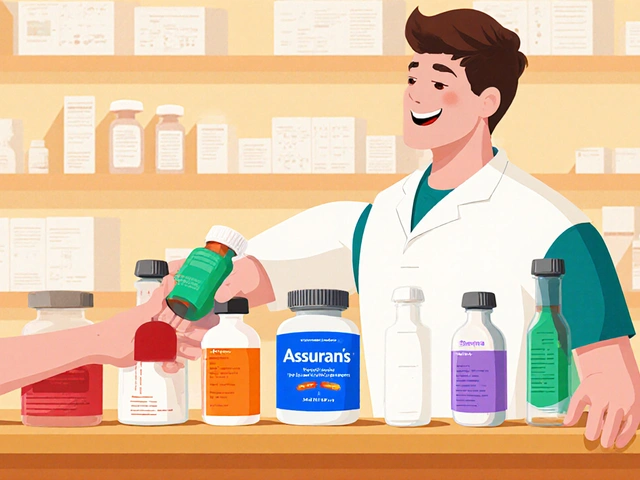Diabetes Medication Comparison Tool
Select two medications to compare their effectiveness, side effects, and cost:
Comparison Results
| Attribute | ||
|---|---|---|
| Average A1C Reduction | ||
| PPG Reduction (2-hr) | ||
| Side Effects | ||
| Typical Monthly Cost |
People with type 2 diabetes often wonder whether Glyset is the best tool for keeping post‑meal blood sugar in check. The answer isn’t black‑and‑white; it depends on how Miglitol stacks up against other options that target the same problem or work in a different way. This guide walks through the major alternatives, compares how they work, costs, side effects, and helps you decide which drug fits your lifestyle.
Key Takeaways
- Miglitol slows carbohydrate breakdown in the gut, making it useful for post‑prandial spikes.
- Acarbose and voglibose belong to the same drug class but differ in dosing frequency and gastrointestinal tolerance.
- DPP‑4 inhibitors (e.g., sitagliptin) and GLP‑1 agonists (e.g., exenatide) control glucose without the stomach‑ache side effects.
- Cost varies widely: generic miglitol and acarbose are cheap, while GLP‑1 agonists can cost several hundred dollars a month.
- Choosing the right drug means balancing efficacy, side‑effect profile, dosing convenience, and insurance coverage.
Understanding the Players
Before diving into the numbers, let’s meet the main contenders.
Glyset (generic name: Miglitol) is an alpha‑glucosidase inhibitor that delays carbohydrate absorption in the small intestine, flattening post‑meal glucose peaks.
Acarbose is another alpha‑glucosidase inhibitor approved in 1995, taken with each main meal.
Voglibose (brand: Basen) is a third alpha‑glucosidase inhibitor marketed mainly in Asia, with a once‑daily dosing option.
Sitagliptin (brand: Januvia) is a DPP‑4 inhibitor that boosts endogenous GLP‑1, improving insulin release after meals.
Exenatide (brand: Byetta) is a GLP‑1 receptor agonist injected twice daily, slowing gastric emptying and reducing appetite.
Empagliflozin (brand: Jardiance) is an SGLT2 inhibitor that increases urinary glucose excretion, providing modest post‑prandial control.
Mechanism of Action: How They Lower Post‑Meal Glucose
All drugs aim to blunt the spike after you eat, but they take different routes.
- Alpha‑glucosidase inhibitors (Miglitol, Acarbose, Voglibose): Sit in the brush border of the small intestine and block enzymes that split complex carbs into absorbable sugars. Result: carbs are digested more slowly, so glucose enters the bloodstream gradually.
- DPP‑4 inhibitors (Sitagliptin): Prevent breakdown of incretin hormones (GLP‑1, GIP). Higher incretin levels boost insulin secretion only when glucose is high, limiting post‑meal spikes without affecting digestion.
- GLP‑1 agonists (Exenatide): Mimic GLP‑1, slowing gastric emptying, reducing glucagon, and enhancing insulin release, all of which smooth out post‑prandial curves.
- SGLT2 inhibitors (Empagliflozin): Block glucose reabsorption in the kidney, spilling excess glucose in urine. While not meal‑specific, they lower overall glucose load, including after meals.
Dosage & Administration
How you take the drug can be a deal‑breaker for daily life.
- Miglitol (Glyset): 50mg tablets taken three times daily with the first bite of each meal. Typical starting dose is 50mg TID, titrated up to 100mg TID.
- Acarbose: 25mg tablets with the first bite of each main meal; can be increased to 100mg TID.
- Voglibose: 0.2mg tablets taken before the first meal of the day; some formulations allow once‑daily dosing.
- Sitagliptin: 100mg once daily, taken with or without food.
- Exenatide: 5µg subcutaneous injection twice daily, within 60minutes before meals.
- Empagliflozin: 10mg oral tablet once daily, with or without food.
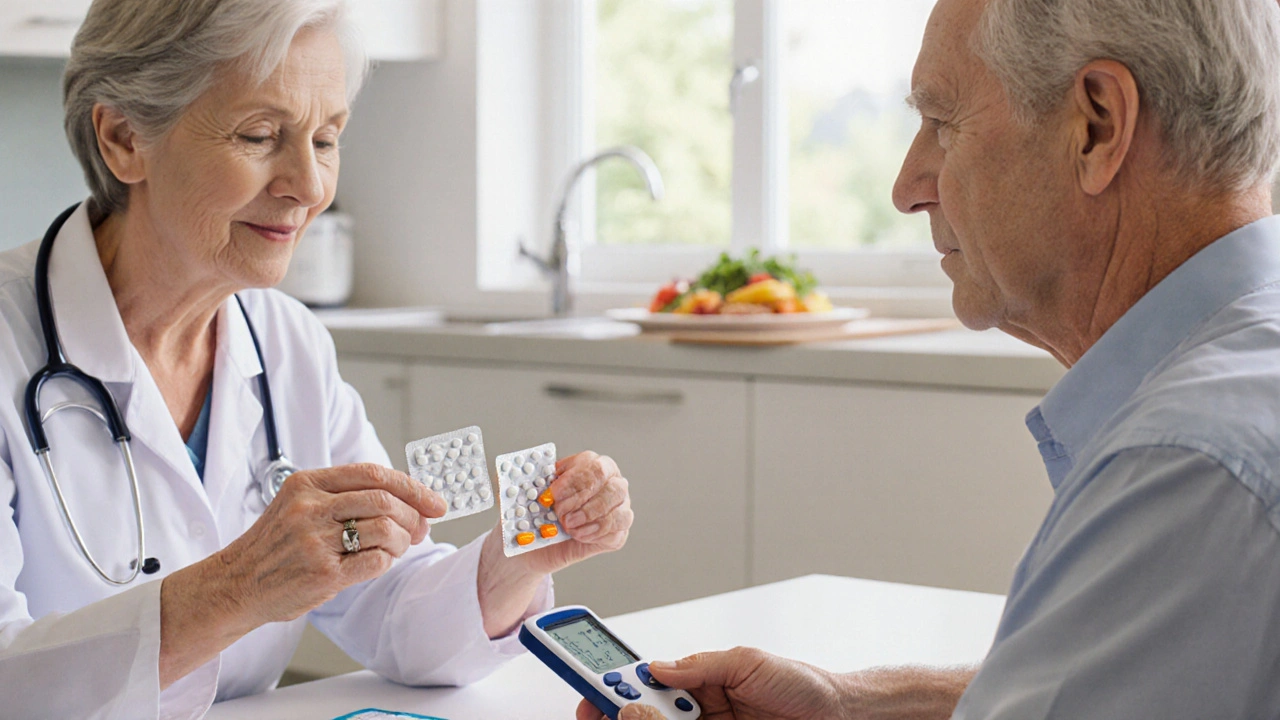
Efficacy: What the Data Shows
Clinical trials give us a sense of how much each drug lowers A1C and post‑prandial glucose (PPG).
| Drug | Average A1C Reduction | PPG Reduction (2‑hr) | Typical Cost (US,/month) |
|---|---|---|---|
| Miglitol | 0.5-0.8% | ≈30mg/dL | $15-$30 (generic) |
| Acarbose | 0.4-0.7% | ≈25mg/dL | $20-$35 (generic) |
| Voglibose | 0.3-0.6% | ≈20mg/dL | $15-$25 (generic in Asia) |
| Sitagliptin | 0.6-0.9% | ≈35mg/dL | $250-$300 (brand) / $30-$50 (generic) |
| Exenatide | 0.7-1.2% | ≈40mg/dL | $350-$400 (brand) |
| Empagliflozin | 0.5-0.8% | ≈25mg/dL | $250-$300 (brand) |
All numbers come from FDA‑registered PhaseIII trials and post‑marketing studies up to 2024. Miglitol’s A1C drop is modest but reliable, especially when combined with lifestyle changes.
Side‑Effect Profile
Gut discomfort is the hallmark of the alpha‑glucosidase inhibitors.
- Miglitol: Flatulence, abdominal bloating, and diarrhea in 15-30% of users. These usually improve after a 2‑week titration period.
- Acarbose: Similar GI issues, but slightly higher incidence of constipation.
- Voglibose: GI side effects modest; some patients report mild nausea.
- Sitagliptin: Generally well tolerated; rare cases of nasopharyngitis and headache.
- Exenatide: Nausea and vomiting are common (up to 25%); risk of pancreatitis, though very low.
- Empagliflozin: Genitourinary infections (UTIs, fungal infections) in ~10% of patients; occasional dehydration.
If you’ve struggled with stomach upset on other medicines, Miglitol’s side‑effect profile may be a decisive factor.
Cost & Insurance Considerations
Price often dictates real‑world adherence.
- Miglitol (generic): $15-$30 per month, widely covered by Medicare PartD and most commercial plans.
- Acarbose: Slightly higher, $20-$35, but still generic.
- Voglibose: In the U.S., not FDA‑approved; cost data limited to import markets, generally cheap.
- Sitagliptin: Generic version is $30-$50, while the brand can exceed $250.
- Exenatide: $350+ per month; many insurers require prior authorization.
- Empagliflozin: $250-$300; some plans offer a $15 copay through discount cards.
When budgeting matters, Miglitol often wins on price without sacrificing modest efficacy.
Decision Matrix: When to Pick Miglitol
Use the following quick‑check to see if Miglitol aligns with your needs.
- If you need targeted post‑prandial control and already manage fasting glucose with metformin, Miglitol can fill the gap.
- If you cannot tolerate injections, stick to oral agents like Miglitol, acarbose, or sitagliptin.
- If you have a history of GI sensitivity, start with a low dose of Miglitol and increase slowly; otherwise consider sitagliptin.
- If cost is a primary concern, generic Miglitol or acarbose are the most affordable.
- If you need weight loss or cardiovascular benefit, GLP‑1 agonists (exenatide) or SGLT2 inhibitors (empagliflozin) may be better.
Ultimately, talk with your clinician about kidney function, liver enzymes, and any other meds you’re taking. Drug‑drug interactions are minimal for Miglitol, but combining it with other glucose‑lowering agents can raise hypoglycemia risk if you’re on insulin or sulfonylureas.
Frequently Asked Questions
Can I take Miglitol with metformin?
Yes. Miglitol is often added to metformin when fasting glucose is under control but post‑meal spikes remain high. No major interaction has been reported.
How quickly does Miglitol start working?
Miglitol begins to inhibit carbohydrate digestion within minutes of the first bite, so you’ll see a smoother glucose curve during that meal.
Is Miglitol safe for people with kidney disease?
Miglitol is excreted unchanged by the kidneys, so dose reduction is recommended for eGFR below 30mL/min. Your doctor can adjust the dose or suggest an alternative.
Why do I get gas on Miglitol and not on sitagliptin?
Miglitol works in the gut, fermenting undigested carbs into gas. Sitagliptin works systemically and doesn’t affect gut enzymes, so it avoids that side effect.
Can I switch from acarbose to Miglitol without a wash‑out period?
Yes. Both belong to the same class, so you can transition directly, usually starting at a low Miglitol dose to gauge tolerance.
